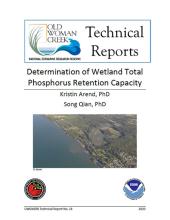
Total Phosphorus (TP) retention in a wetland is a measure of the storage via either short-term or long-term processes. Each of these types of processes has a retention capacity, which is the maximum amount of total phosphorus it can store. Short-term storage includes plants, algae, microbes, and the soil (via adsorption and precipitation). Long-term phosphorus storage occurs when TP is buried and retained in the sediment. This long-term storage is what determines a wetland ’s long-term retention capacity and is a function of the rate of sediment accretion in the wetland.
About this document
This protocol is intended to enable wetland managers, conservationists, and other practitioners to monitor and estimate a wetland ’s long-term Total Phosphorus retention capacity threshold. The protocol provides specific guidance on how to sample and analyze influent and effluent total phosphorus and enables users to calculate their wetland ’s retention capacity using the team's Baysian hierarchical modeling approach. Tools to facilitate data analysis and interpretation are available on the project's GitHub Repository - Retention capacity code and cloud-based model interface
This estimation method can be applied to flow-through wetlands; i.e., wetlands that have a distinct point of inflow (e.g., stream or pump) and point of outflow (e.g., stream or water control structure). The method can be adapted to monitor the performance of wetlands that have been restored, enhanced or constructed.
Arend, K. and S. Qian. 2020. Determination of wetland total phosphorus retention capacity. Old Woman Creek Technical Report No. 18, Ohio Department of Natural Resources. Huron, OH.